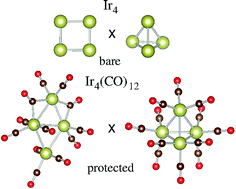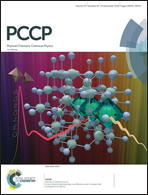Bare versus protected tetrairidium clusters by density functional theory†
Abstract
The tetrairidium (Ir4) clusters are subnanometric systems vastly applied in catalysis, especially, because of the higher activity than mononuclear Ir complexes, intrinsic and controllable stability in relation to supports, and non-coalescence properties. The main catalytic properties of nanoclusters (activity and selectivity) are directly associated with their size, shape, and interactions with the environment, whose understanding requires study at the atomistic level. Here, the Ir4 clusters are studied considering the energetic stability for different chemical environments, bare versus protected, using density functional theory calculations within the generalized gradient approximation with van der Waals corrections and spin–orbit coupling, employing the all-electron projected augmented wave method. The square planar isomer is confirmed for the bare case as the lowest energy configuration considering semilocal and non-local exchange–correlation functionals, however, for different chemical environments (Ir4 protected by CO, O2, PH3, and SH2 ligands) the energy stability scenario is different; for CO, O2, and PH3 ligands the tetrahedron is the most stable isomer, in agreement with experimental insights, while for SH2 ligands the square motif is the most stable isomer. To improve the understanding of these systems, structural and electronic analysis were performed, in addition to energy decomposition analysis, to explore the bonding situation in Ir4 compounds. Our results showed an important relationship between the geometrical behavior and the nature and magnitude of Ir2⋯Ir2 interactions, showing how the chemical environment affects the Ir4 nanoclusters. In general, the compounds with tetrahedron motifs showed a weakening of the σ and π bonds in relation to the square ones.



 Please wait while we load your content...
Please wait while we load your content...